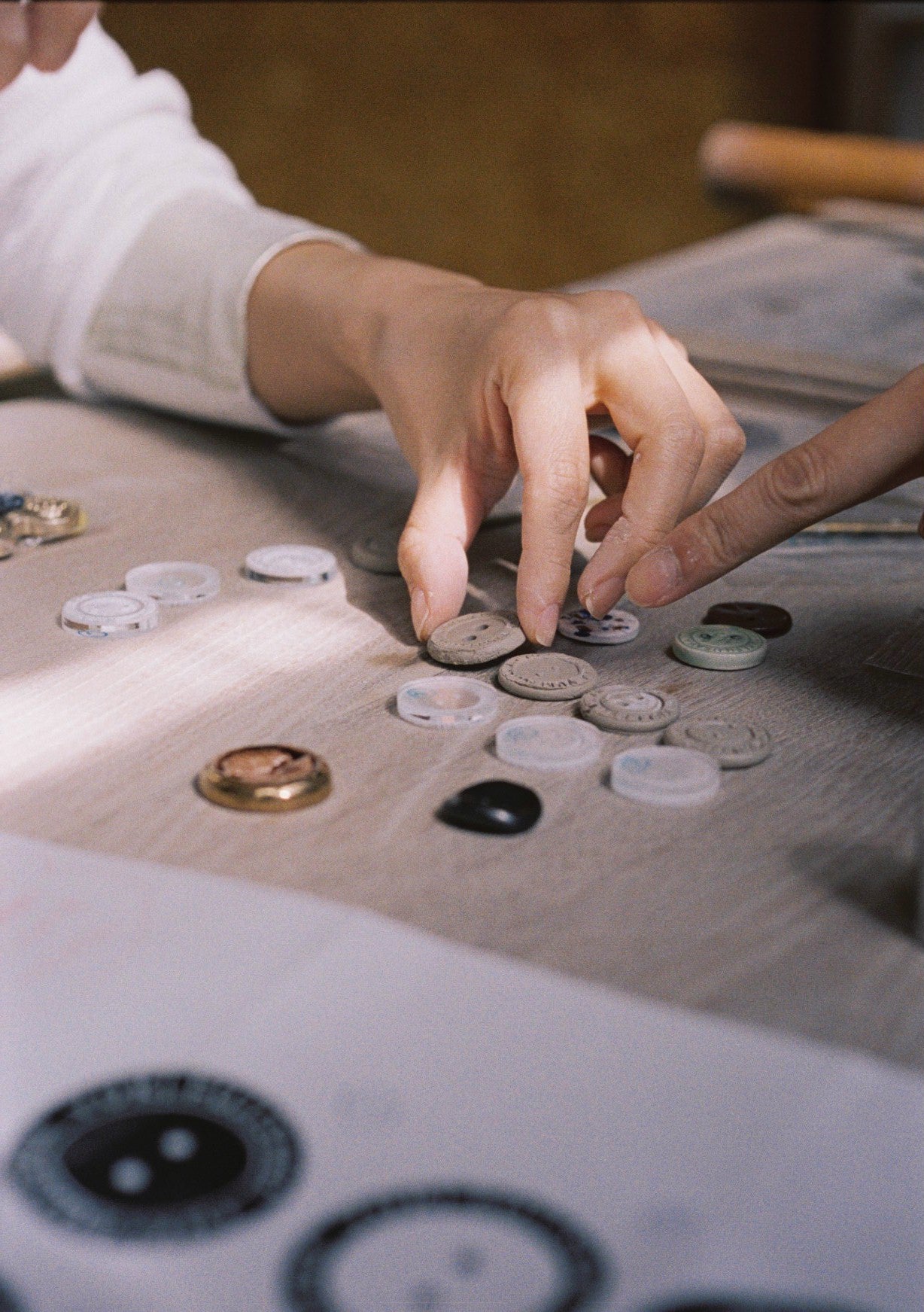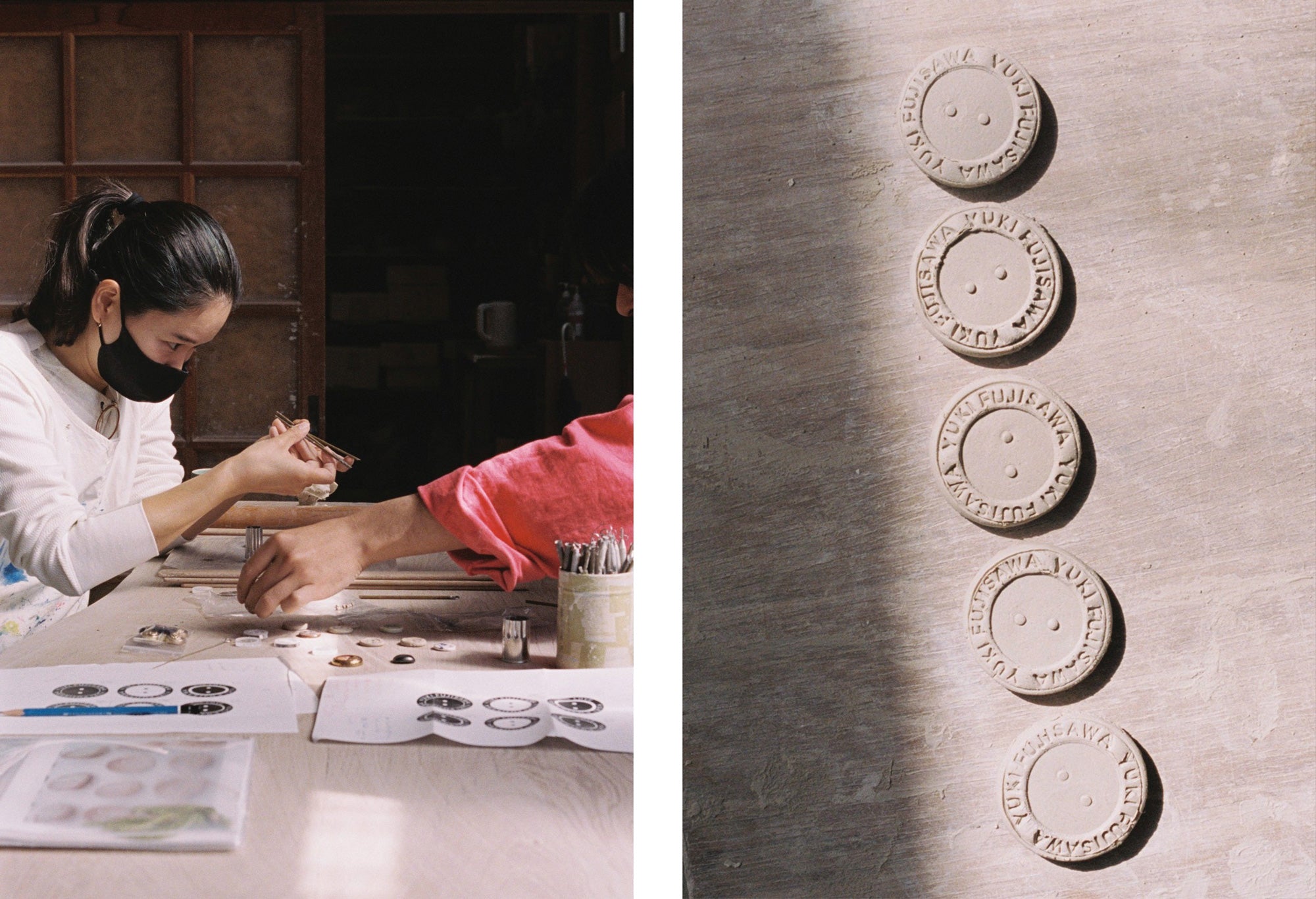"Pottery button" Knitting memory Sweater production diary (3)
STORY | 2022/10/20

A sunny autumn day with no clouds. Yuki visited a workshop in Chiba Prefecture. This is the studio of ceramic artist Yoshinori Takemura. When I stopped by at the appointed time, Mr. Takemura greeted me with a cup of tea.
“There is someone in our workshop every day,” says Takemura. “There are a number of apprentices who come to help me, and students from the pottery class. We have meetings here, and we also shop here. It's interesting because the jobs of the people who come here are all different, and if you listen carefully to how they think, they're all different, so it's interesting."
Even on the day they first met, they were drinking tea like this. It all started when Yuki bought a container made by Takemura. We talked about having tea next time, so Yuki visited Mr. Takemura's workshop. When I was talking while drinking tea, nearly three hours had passed before I knew it.
"I don't think I've ever had a long cup of tea with someone I met for the first time," laughs Yuki. “I was shocked by the feeling that all the shutters in my heart were open to the extent that the word “open-minded” would not be enough.”

If you usually deal with soft fabrics, the time will come when you will be attracted to hard ones. At one point, Yuki attended Takemura's pottery class, partly because he was attracted to his works and personality. An idea was born from the time spent in that way.
In March 2019, YUKI FUJISAWA held a presentation titled "1000 memories of" memory workshop at the Hara Museum of Contemporary Art. As the title suggests, the theme was "memory".
YUKIFUJISAWA has created a series titled "NEW VINTAGE" by applying foil to vintage clothes. In other words, it can be said that the knitted fabric filled with someone's memories has been modified and handed over to someone else. When it was decided to hold a presentation for the first time at the Hara Museum of Contemporary Art, Yuki wondered if it would be possible to interact with the visitors in some way rather than just showing the works. That's when I came up with the idea of recruiting "memories." A question box was set up at the venue, and "memory currency" was handed to visitors who wrote down their own memories there. This currency of memory is made of ceramics, and was an idea that was born while visiting Mr. Takemura's atelier.

What came to Yuki's mind when creating a sweater from scratch was this memory currency. Could it be possible to make buttons for sweaters out of porcelain, just as the coins were made out of porcelain back then? --and.
“Aran sweaters have a lot of wooden buttons. There are leather buttons in the shape of melon bread, and in recent years there are many plastic buttons that look like wood. Remembering the currency of memory.There are so many colors, and I thought it would be nice if people who made custom orders could choose their favorite color, so I made a mold using a technique similar to that time.”
Yuki takes out some molds from her bag. When you make a memory currency, you first cut out a mold from the clay, press the mold into it to make a pattern, wait for it to dry, and then fire it unglazed. Glaze is applied to the baked product, and the final firing is complete. But unlike memory currency, buttons require holes.

“If the button holes are too small, will it be difficult to open them?”
“It can be made smaller, but if the space between the holes is too narrow, cracks will appear between them.
"It shrinks."
"It will shrink and it can get filled with some glaze."
"It's hard to imagine how it will look like when it's baked. Should I make the holes 4mm or 3mm? I think 3mm would be better before baking, but if it shrinks, it will be difficult to thread the knitting needles through. Considering shrinkage, 4mm is better—how many millimeters do you think it will be when baked?”
"It's about 3.5 millimeters."
“Hmm, it might be a little big.

Yuki takes a thread out of her bag and threads it through a cut button. Thread one thread through the hole twice. "Yeah. It's still dirt, but it's cute," Yuki muttered.
“If the buttonhole is too big, the hole will be visible, but with this yarn, it might not be so noticeable,” says Takemura.
"Yeah. After that, the impression may change depending on your senses. Even if the holes are large, if the spacing between the holes is about this――"
"Maybe you won't mind. If the spacing is too wide, the thread will run across the middle, giving the impression of a hole."
The two take the button, which is still in its clay state, and imagine how it will be baked as they thread the thread through it. I feel that pottery is also a job of imagining the future in light of past experiences.

Once the button design is fixed, it's time for mass production. A molding technique called "tatara" is used to make buttons.
“When I think of pottery, I think that what comes to mind is the method of shaping with a potter's wheel, but there is also the method of creating distorted things called tebineri.” Mr. Takemura explains the setup. “This also belongs to Tebineri, but there is a way of making it called Tatara. These wooden boards are called Tatara. This sheet-shaped clay is also called "tatara", and the sheet-shaped flat clay is rolled around to form a flat surface. You can also combine them to make a cup-shaped thing.”
From here on, Yuki and her college classmate Sao-chan will work together. It is said that she helped me with the work when I made the memory currency, and also helped when I held an order party at the atelier.

Put the clay on the workbench and stretch it vertically and horizontally with a rolling pin. Remove the mold when it is evenly conditioned. Lightly powder the clay that has been cut out to the size of the button and press it. It is unexpectedly difficult to peel off the clay that has been embossed here. If you apply force to peel it off, the clay will be slightly distorted. So that it can be peeled off cleanly, powder is pounded on the clay.
"It's kind of like making cookies."
"I probably haven't made cookies since middle school."
"It's fun, but it's hard to peel off cleanly. It's just a little distorted."
"But I like things that are a little distorted rather than machine-made."
“Yes.
There is a possibility that some ceramic buttons may break during baking, or some may not be baked well. I need to make 200 by today's dusk with time to spare. Yuki-san, Sao-chan, and Wahei Kimura, who was taking photos, joined in the middle of the process and proceeded with the division of labor, and in no time nearly 100 buttons were completed. At just the right moment, Mr. Takemura cut a pear and brought it to us. There is something cute about a plate of pears. I heard that the plate was made at Yasuragi no Mori, a facility for people with disabilities in Nerima Ward. At Yasuragi-no-Mori, the artistic activities of the people who live there are called "PoMA" (Peace Of Mind Art), and they are presenting their works.

"PoMA's work is really good." Mr. Takemura says while pouring tea. The mug that Mr. Takemura uses every day is also a work of PoMA. “The creators of PoMA don’t make things that hard, they just do what they want and as much as they want. If you start looking for efficiency and thinking about what fits everyone, you'll start to get confused as a creator, but this work is close to the ideal of what you create. Yamamoto-san, who made this plate, has passed away, but he really liked the idea of selling his work, because if he sold his work, he would get money and buy the sweets he liked. I certainly thought so. I would be happy if it sold.”
After eating the delicious pears, I resumed making buttons. The sun is slowly setting and the room is getting darker. However, this workshop was renovated from the place where Mr. Takemura's father ran a construction company, and the ceiling is originally high, and there is a window above the glass door, so there is a lot of light. come in.

“What would Takemura-san be if he weren't a potter?” Yuki asks.
“There was a time when I was thinking of going to the Faculty of Science and Technology, so I might have gone for a design or engineering job instead of art. Because of that, I guess that's how it works."
“It’s true that being a potter is a job that does both.”
"It's like dividing the sum by two. If you weren't a designer, what do you think you would have become?"
"I don't know. I have no idea." Yuki continued to speak while making buttons. “However, I always feel that choosing my own path is a very small opportunity. Isn't it better to go to?' Of course, that word isn't everything, but when I was wondering whether to go into psychology or go to art school, my teacher said, The teacher must have seen me drawing posters for club activities—I think he said that after seeing a scene from school life, but that kind of thing unexpectedly decided his path. I think you will."
Everyone who sits around the desk in the atelier like this is from a different place of birth and is of different ages, but the coincidences overlapped to bring us to where we are today.
“Yuki-chan, compared to before, her corners are nicely rounded, and she’s getting a nice shape.” Sao-chan says, looking back on her school days.
"Yeah, yeah. Compared to those days, my heart is calmer," Yuki-san laughs. I imagine that in the early stages of manufacturing, before the industrialization and mechanization that we have today, people would chat like this when making products. Watching the work being done gives me the feeling that the atmosphere of conversation is kneaded into the clay.

WordsRinshi Hashimoto
Photo Kazuhei Kimura